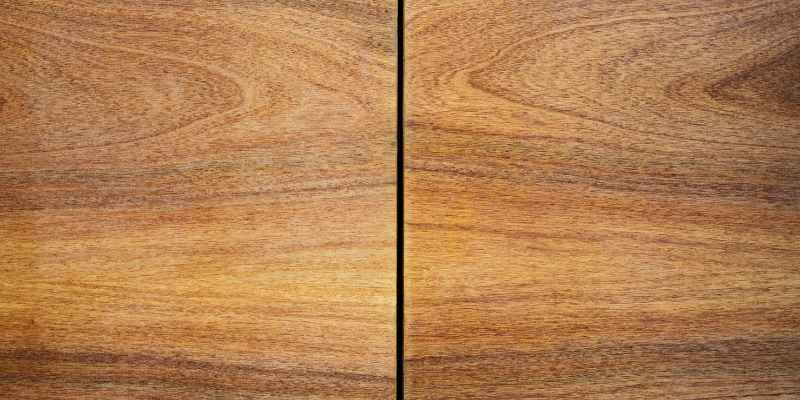Satin wood finish is a medium-sheen finish that appears velvety, with a luster between flat and glossy. It is slightly more reflective and durable than eggshell.
For those looking to enhance the aesthetic appeal of their wood surfaces without the high shine of gloss finishes, satin wood finish serves as an excellent choice. The satin finish provides a subtle sheen that adds sophistication and elegance to furniture, cabinets, and other wood surfaces.
Its versatility allows it to complement various design styles, from modern to traditional. Moreover, satin finish conceals imperfections well, making it a practical choice for surfaces with minor flaws. With its durability and ease of maintenance, satin wood finish is a popular option for achieving a smooth, refined look in interior spaces.
Characteristics
Satin wood finish has a unique set of characteristics that distinguish it from other finishes.
Velvety Luster
Velvety luster: Satin finish offers a beautiful sheen, appearing velvety and slightly less lustrous than semigloss. It has a soft, elegant appearance that can vary between being flat and glossy based on the lighting.
Reflectivity And Durability
Reflectivity: Satin finish has a higher sheen compared to eggshell, making it more reflective. It can enhance the overall look of the wood surface and provide a subtle shine.
Durability: Satin finish is known for its durability, offering good resistance to wear and tear. It is a great choice for interior woodwork that needs a moderate sheen and can help conceal minor imperfections such as scratches or dents.
Comparison With Other Finishes
Satin wood finish is a versatile option for interior woodwork, providing a beautiful luster that is both flat and glossy depending on lighting. It has a higher sheen than eggshell, making it more durable and reflective. Satin paint is also great for hiding imperfections and is less reflective than gloss paint.
Satin Vs. Matte Finish
A satin wood finish and a matte finish are both popular choices for interior woodwork. While they share some similarities, they have distinct differences that make them suitable for different purposes.
Satin finish:
- Has a medium sheen that gives the woodwork a soft, velvety appearance.
- Offers a beautiful luster that can appear both flat and glossy, depending on the lighting in the room.
- Has a slightly higher sheen compared to eggshell, making it more reflective and durable.
Matte finish:
- Has a low sheen that creates a smooth, non-reflective surface.
- Gives the woodwork a subtle, understated appearance.
- Conceals imperfections well, making it ideal for woodwork that is not in perfect condition, as it can hide dents, scratches, or chips.
Satin Vs. Gloss Finish
When choosing between a satin finish and a gloss finish for your interior woodwork, it’s important to consider the level of shine and reflection you desire.
Satin finish:
- Has a medium sheen, making it less reflective than a gloss finish.
- Provides a more subtle shine, giving the woodwork a sophisticated and elegant look.
- Can help create a warm and inviting atmosphere in the room.
Gloss finish:
- Has a high sheen that creates a reflective surface.
- Offers a bright and polished appearance to the woodwork.
- Can make a space appear larger and more vibrant.
In conclusion, the choice between a satin finish, matte finish, or gloss finish depends on your preference and the desired look for your interior woodwork. Satin finish provides a beautiful luster with a medium sheen, while matte finish offers a non-reflective surface. On the other hand, gloss finish provides a high shine and reflective surface. Consider the lighting in the room, the condition of the woodwork, and the overall aesthetic you want to achieve when making your decision.
Application And Use
Satin wood finish offers a smooth luster, resembling a velvety appearance with a moderate sheen. It strikes a balance between flat and glossy, depending on the lighting. Ideal for interior woodwork with minor imperfections, satin paint conceals dents and scratches well, making it a popular choice.
Ideal Surfaces For Satin Finish
Satin wood finish is a versatile option that can be applied to a variety of surfaces. It works particularly well on wooden furniture, cabinets, trim, and doors, providing a smooth and sleek appearance. The satin finish adds a touch of elegance to these surfaces and enhances the natural beauty of the wood grain.
Additionally, satin finish is also suitable for acoustic wood panels, musical instruments, and even certain types of flooring, such as engineered wood or hardwood floors. Its durable and lustrous nature makes it an ideal choice for high-traffic areas.
Advantages Over Gloss And Matte Finishes
When it comes to choosing a wood finish, satin offers several advantages over gloss and matte finishes.
| Advantage | Description |
|---|---|
| Slight Sheen | The satin finish provides a subtle sheen that adds depth and dimension to the surface, without being as reflective as gloss or as flat as matte. This sheen helps to highlight the natural beauty of the wood without being overly shiny. |
| Conceals Imperfections | Satin finish is great for surfaces with small imperfections, as it helps to hide scratches, dents, and blemishes. Its slightly lustrous nature draws less attention to these flaws, creating a more visually appealing appearance. |
| Durable and Resistant | Satin wood finish offers excellent durability and resistance to wear and tear. It can withstand regular use and cleaning, making it a long-lasting choice for surfaces that experience high traffic or frequent handling. |
| Easy to Clean | Satin finish is relatively easy to clean and maintain. It can be wiped down with a damp cloth or mild cleaning solution without leaving streaks or watermarks. This makes it a practical choice for areas prone to dirt, dust, or spills. |
Overall, satin wood finish strikes a balance between the high-shine of gloss and the ultra-matte of matte finishes. It offers a smooth, velvety appearance that complements various wood surfaces and provides a versatile option for both modern and traditional aesthetics.
Pros And Cons
The satin wood finish offers a balanced sheen that adds elegance to any piece of wood. Let’s explore the Pros and Cons of using a satin finish.
Advantages Of Satin Finish
- Enhances the natural beauty of wood
- Provides a smooth, velvety appearance
- Offers moderate durability
- Conceals minor imperfections well
- Less reflective than gloss, suitable for interior woodwork
Drawbacks Of Satin Finish
- Reflects more light than matte finishes
- Shows imperfections more clearly
- May not be suitable for rough or damaged surfaces
- Requires proper preparation for a flawless application
- Can make small spaces with low light appear larger
Distinguishing Features
Satin wood finish offers unique characteristics that set it apart from other finishes.
Satinwood Vs. Eggshell
Satinwood provides a subtle luster resembling velvet, appearing both flat and glossy based on lighting. This finish offers higher sheen compared to eggshell, enhancing durability.
Satinwood Vs. Gloss
In contrast to gloss, satin wood finish presents a medium-sheen texture that is less reflective. Satin finish can hide minor imperfections like dents or scratches on wooden surfaces.
Maintaining Satin Finish
Satin wood finish has a slightly reflective and velvety appearance, providing a beautiful luster. It offers a durable yet low-sheen finish, ideal for interior woodwork that may not be in perfect condition. Satin finish can help conceal minor imperfections, such as dents and scratches, while enhancing the overall aesthetics of the wood.
Cleaning And Care Tips
To maintain the beauty and longevity of your satin wood finish, proper cleaning and care are essential. Here are some tips to keep your satin finish looking its best:
1. Dust regularly: Use a soft, lint-free cloth or a feather duster to remove dust and dirt from the surface of your wood furniture. Avoid using rough materials or abrasive cleaners that can scratch or damage the finish.
2. Gentle cleaning: If your satin wood finish gets dirty or stained, clean it immediately using a mild soap and water solution. Dampen a cloth with the soapy water and gently wipe the surface in the direction of the wood grain. Avoid using excessive moisture, as it can seep into the wood and cause damage.
3. Avoid harsh chemicals: Harsh chemicals, such as ammonia-based cleaners or bleach, can strip away the protective layer of your wood finish and cause discoloration. Stick to gentle, non-abrasive cleaners specifically designed for wood surfaces.
4. Protect from heat and moisture: Satin wood finishes are sensitive to extreme temperatures and high humidity levels. Avoid placing hot objects directly on the surface, as it can cause heat marks or discoloration. Additionally, use coasters or placemats to protect your furniture from spills and water rings.
5. Regular maintenance: To maintain the satin sheen of your wood finish, apply a thin layer of wood polish or wax every few months. This will help restore the shine and provide an additional protective layer against scratches and moisture.
Preventing Wear And Tear
In addition to regular cleaning and care, taking preventive measures can help prolong the lifespan of your satin wood finish. Here are some tips:
1. Use protective pads: Place felt or rubber pads under table legs, chair feet, or any objects in contact with the wood surface. This will prevent scratches and dents when moving or sliding furniture.
2. Avoid direct sunlight: Prolonged exposure to direct sunlight can fade the color of your wood finish. Consider using curtains or blinds to protect your furniture from harmful UV rays.
3. Handle with care: When moving or handling furniture with a satin wood finish, lift it instead of dragging or pushing it across the floor. This will prevent scratches and damage to the finish.
4. Touch-up when necessary: If you notice any scratches or blemishes on your satin wood finish, address them promptly. Use a touch-up marker or a matching wood stain to conceal minor imperfections and maintain the overall aesthetic of the furniture.
By following these cleaning and maintenance tips, you can ensure that your satin wood finish retains its beauty and durability for years to come. Remember to always consult the manufacturer’s instructions for specific care recommendations for your particular wood finish.

Frequently Asked Questions On What Is Satin Wood Finish
What Does Satin Wood Finish Look Like?
A satin wood finish has a beautiful velvety luster, appearing both flat and glossy depending on lighting. It’s less reflective than semi-gloss, but more durable and can hide imperfections.
Is Satin Wood Better Than Gloss?
Satin wood finish is ideal for painted interior woodwork with imperfections as it’s less reflective than gloss.
What Are The Cons Of Satin Finish?
The cons of a satin finish are that it can make small spaces with low light look larger, but it also shows imperfections more. It is not recommended for walls with lots of prior drywall patches or repairs. Satin finish is less reflective than gloss paint and can help hide small imperfections.
Is Satin Wood The Same As Eggshell?
Satin wood and eggshell are different paint finishes. Satin wood has a slightly higher sheen and is more reflective and durable compared to eggshell. Satin wood is a good choice for interior woodwork that needs to be painted and is not in perfect condition.
Gloss vs. Satin Paint for Interior Woodwork – Paint Direct
Conclusion
Satin wood finish offers a velvety appearance with a moderate sheen. It strikes a balance between flat and glossy, adding durability and reflection to your woodwork. Consider these points when choosing between satin and other finishes for a perfect touch.


